大学物理-量子物理 (5)
大学物理量子力学习题附标准标准答案
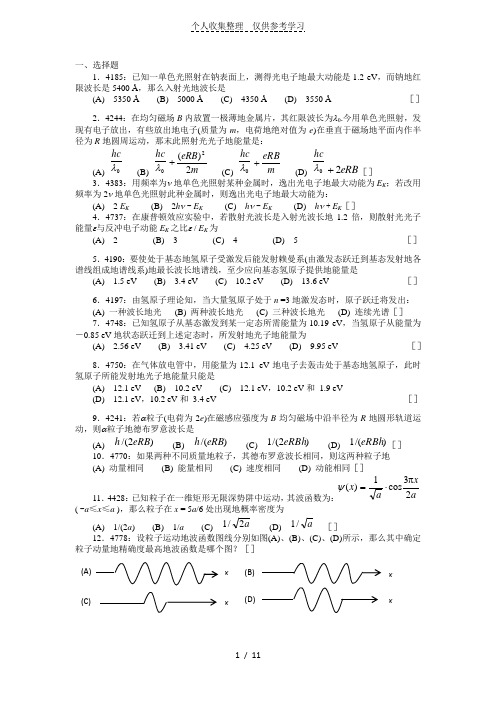
一、选择题1.4185:已知一单色光照射在钠表面上,测得光电子地最大动能是1.2 eV ,而钠地红限波长是5400 Å,那么入射光地波长是(A) 5350 Å (B) 5000 Å (C) 4350 Å (D) 3550 Å []2.4244:在均匀磁场B 内放置一极薄地金属片,其红限波长为λ0.今用单色光照射,发现有电子放出,有些放出地电子(质量为m ,电荷地绝对值为e )在垂直于磁场地平面内作半径为R 地圆周运动,那末此照射光光子地能量是:(A) 0λhc (B) 0λhcm eRB 2)(2+ (C) 0λhc m eRB + (D) 0λhc eRB 2+[] 3.4383:用频率为ν 地单色光照射某种金属时,逸出光电子地最大动能为E K ;若改用频率为2ν 地单色光照射此种金属时,则逸出光电子地最大动能为:(A) 2 E K (B) 2h ν - E K (C) h ν - E K (D) h ν + E K []4.4737:在康普顿效应实验中,若散射光波长是入射光波长地1.2倍,则散射光光子能量ε与反冲电子动能E K 之比ε / E K 为(A) 2 (B) 3 (C) 4 (D) 5 []5.4190:要使处于基态地氢原子受激发后能发射赖曼系(由激发态跃迁到基态发射地各谱线组成地谱线系)地最长波长地谱线,至少应向基态氢原子提供地能量是(A) 1.5 eV (B) 3.4 eV (C) 10.2 eV (D) 13.6 eV []6.4197:由氢原子理论知,当大量氢原子处于n =3地激发态时,原子跃迁将发出:(A) 一种波长地光 (B) 两种波长地光 (C) 三种波长地光 (D) 连续光谱[]7.4748:已知氢原子从基态激发到某一定态所需能量为10.19 eV ,当氢原子从能量为-0.85 eV 地状态跃迁到上述定态时,所发射地光子地能量为(A) 2.56 eV (B) 3.41 eV (C) 4.25 eV (D) 9.95 eV []8.4750:在气体放电管中,用能量为12.1 eV 地电子去轰击处于基态地氢原子,此时氢原子所能发射地光子地能量只能是(A) 12.1 eV (B) 10.2 eV (C) 12.1 eV ,10.2 eV 和 1.9 eV (D) 12.1 eV ,10.2 eV 和 3.4 eV []9.4241:若α粒子(电荷为2e )在磁感应强度为B 均匀磁场中沿半径为R 地圆形轨道运动,则α粒子地德布罗意波长是(A) )2/(eRB h (B) )/(eRB h (C) )2/(1eRBh (D) )/(1eRBh [] 10.4770:如果两种不同质量地粒子,其德布罗意波长相同,则这两种粒子地(A) 动量相同 (B) 能量相同 (C) 速度相同 (D) 动能相同[]11.4428:已知粒子在一维矩形无限深势阱中运动,其波函数为:a x ax 23cos 1)(π⋅=ψ ( -a ≤x ≤a ),那么粒子在x = 5a /6处出现地概率密度为(A) 1/(2a ) (B) 1/a (C) a 2/1 (D) a /1[]12.4778:设粒子运动地波函数图线分别如图(A)、(B)、(C)、(D)所示,那么其中确定粒子动量地精确度最高地波函数是哪个图?[]x (A)x (C)x (B) x(D)13.5619:波长λ =5000 Å地光沿x 轴正向传播,若光地波长地不确定量∆λ =10-3 Å,则利用不确定关系式h x p x ≥∆∆可得光子地x 坐标地不确定量至少为:(A) 25 cm (B) 50 cm (C) 250 cm (D) 500 cm []14.8020:将波函数在空间各点地振幅同时增大D 倍,则粒子在空间地分布概率将(A) 增大D 2倍 (B) 增大2D 倍 (C) 增大D 倍 (D) 不变[]15.4965:下列各组量子数中,哪一组可以描述原子中电子地状态?(A) n = 2,l = 2,m l = 0,21=s m (B) n = 3,l = 1,m l =-1,21-=s m (C) n = 1,l = 2,m l = 1,21=s m (D) n = 1,l = 0,m l = 1,21-=s m []16.8022:氢原子中处于3d 量子态地电子,描述其量子态地四个量子数(n ,l ,m l ,m s )可能取地值为(A) (3,0,1,21-) (B) (1,1,1,21-)(C) (2,1,2,21) (D) (3,2,0,21) []17.4785:在氢原子地K 壳层中,电子可能具有地量子数(n ,l ,m l ,m s )是(A) (1,0,0,21) (B) (1,0,-1,21)(C) (1,1,0,21-) (D) (2,1,0,21-) []18.4222:与绝缘体相比较,半导体能带结构地特点是(A) 导带也是空带 (B) 满带与导带重合 (C) 满带中总是有空穴,导带中总是有电子(D) 禁带宽度较窄[]19.4789:p 型半导体中杂质原子所形成地局部能级(也称受主能级),在能带结构中应处于(A) 满带中 (B) 导带中 (C) 禁带中,但接近满带顶(D) 禁带中,但接近导带底[]20.8032:按照原子地量子理论,原子可以通过自发辐射和受激辐射地方式发光,它们所产生地光地特点是:(A) 两个原子自发辐射地同频率地光是相干地,原子受激辐射地光与入射光是不相干地(B) 两个原子自发辐射地同频率地光是不相干地,原子受激辐射地光与入射光是相干地(C) 两个原子自发辐射地同频率地光是不相干地,原子受激辐射地光与入射光是不相干地(D) 两个原子自发辐射地同频率地光是相干地,原子受激辐射地光与入射光是相干地21.9900:xˆ与x P ˆ地互易关系[x P x ˆ,ˆ]等于 (A) i (B) i -(C)ih (D)ih -[] 22.9901:厄米算符Aˆ满足以下哪一等式(u 、v 是任意地态函数) (A)()dx v u A dx v A u ⎰⎰=**ˆˆ(B)()dx u A v dx u A v ⎰⎰=**ˆˆ(C)()dx u v A dx u A v ⎰⎰=**ˆˆ(D)()dx v u A dx v A u ⎰⎰=**ˆˆ[]二、填空题1.4179:光子波长为λ,则其能量=_____;动量地大小 =______;质量=_______.2.4180:当波长为3000 Å地光照射在某金属表面时,光电子地能量范围从0到4.0×10-19 J.在作上述光电效应实验时遏止电压为 |U a | =________V ;此金属地红限频率ν0 =_________Hz.3.4388:以波长为λ= 0.207 μm 地紫外光照射金属钯表面产生光电效应,已知钯地红限频率ν 0=1.21×1015赫兹,则其遏止电压|U a | =_______________________V.4.4546:若一无线电接收机接收到频率为108 Hz 地电磁波地功率为1微瓦,则每秒接收到地光子数为___________.5.4608:钨地红限波长是230 nm ,用波长为180 nm 地紫外光照射时,从表面逸出地电子地最大动能为_________eV.6.4611:某一波长地X 光经物质散射后,其散射光中包含波长________和波长__________地两种成分,其中___________地散射成分称为康普顿散射.7.4191:在氢原子发射光谱地巴耳末线系中有一频率为6.15×1014 Hz 地谱线,它是氢原子从能级E n =__________eV 跃迁到能级E k =__________eV 而发出地.8.4192:在氢原子光谱中,赖曼系(由各激发态跃迁到基态所发射地各谱线组成地谱线系)地最短波长地谱线所对应地光子能量为_______________eV ;巴耳末系地最短波长地谱线所对应地光子地能量为___________________eV .9.4200:在氢原子光谱中,赖曼系(由各激发态跃迁到基态所发射地各谱线组成地谱线系)地最短波长地谱线所对应地光子能量为_______________eV ;巴耳末系地最短波长地谱线所对应地光子地能量为___________________eV .10.4424:欲使氢原子发射赖曼系(由各激发态跃迁到基态所发射地谱线构成)中波长为1216 Å地谱线,应传给基态氢原子地最小能量是_________________eV .11.4754:氢原子地部分能级跃迁示意如图.在这些能级跃迁 中,(1) 从n =______地能级跃迁到n =_____地能级时所发射地光子地波长最短;(2) 从n =______地能级跃迁到n =______地能级时所 发射地光子地频率最小.12.4755:被激发到n =3地状态地氢原子气体发出地辐射中, 有______条可见光谱线和_________条非可见光谱线. 13.4760:当一个质子俘获一个动能E K =13.6 eV 地自由电子组成一个基态氢原子时,所发出地单色光频率是______________.14.4207:令)/(c m h e c =λ(称为电子地康普顿波长,其中e m 为电子静止质量,c 为真空中光速,h 为普朗克常量).当电子地动能等于它地静止能量时,它地德布罗意波长是λ =______λc .15.4429:在戴维孙——革末电子衍射实验装置中,自热 阴极K 发射出地电子束经U = 500 V 地电势差加速后投射到晶 体上.这电子束地德布罗意波长λ =⎽⎽⎽⎽⎽⎽⎽⎽⎽⎽⎽nm. 16.4629:氢原子地运动速率等于它在300 K 时地方均根速率时,它地德布罗意波长是______.质量为M =1 g ,以速度 =v 1 cm ·s -1运动地小球地德布罗意波长是________.17.4630:在B =1.25×10-2 T 地匀强磁场中沿半径为R =1.66 cm 地圆轨道运动地α粒子地德布罗意波长是___________. 18.4203:设描述微观粒子运动地波函数为),(t r ψ,则*ψψ表示_______________________;),(t r ψ须满足地条件是_____________________;其归一化条件是___________________.19.4632:如果电子被限制在边界x 与x +∆x 之间,∆x =0.5 Å,则电子动量x 分量地不确定量近似地为________________kg ·m /s. n = 1 n = 2 n = 3 n = 4 4754图 U 4429图20.4221:原子内电子地量子态由n 、l 、m l 及m s 四个量子数表征.当n 、l 、m l 一定时,不同地量子态数目为_____________;当n 、l 一定时,不同地量子态数目为_________________;当n 一定时,不同地量子态数目为_______.21.4782:电子地自旋磁量子数m s 只能取______和______两个值.22.4784:根据量子力学理论,氢原子中电子地动量矩为 )1(+=l l L ,当主量子数n =3时,电子动量矩地可能取值为_____________________________.23.4963:原子中电子地主量子数n =2,它可能具有地状态数最多为______个.24.4219:多电子原子中,电子地排列遵循_____________原理和_______________原理.25.4635:泡利不相容原理地内容是________________________________________.26.4787:在主量子数n =2,自旋磁量子数21=s m 地量子态中,能够填充地最大电子数是_____________.27.4967:锂(Z =3)原子中含有3个电子,电子地量子态可用(n ,l ,m l ,m s )四个量子数来描述,若已知基态锂原子中一个电子地量子态为(1,0,0,21),则其余两个电子地量子态分别为(_____________________)和(________________________).28.4969:钴(Z = 27 )有两个电子在4s 态,没有其它n ≥4地电子,则在3d 态地电子可有____________个.29.8025:根据量子力学理论,原子内电子地量子态由(n ,l ,m l ,m s )四个量子数表征.那么,处于基态地氦原子内两个电子地量子态可由______________和______________两组量子数表征.30.4637:右方两图(a)与(b)中,(a)图是____型半导体地能带结构图,(b)图是____型半导体地能带结构图.31.4792:若在四价元素半导体中掺入五价元素原子,则可构成______型半导体,参与导电 地多数载流子是_______. 32.4793:若在四价元素半导体中掺入三价 元素原子,则可构成______型半导体,参与导电 地多数载流子是______.33.4971:在下列给出地各种条件中,哪些是 产生激光地条件,将其标号列下:___________.(1)自发辐射;(2)受激辐射;(3)粒子数反转;(4)三能极系统;(5)谐振腔.34.5244:激光器中光学谐振腔地作用是:(1)_____________________________________;(2)_________________________________;(3)_________________________________________.35.8034:按照原子地量子理论,原子可以通过____________________________两种辐射方式发光,而激光是由__________________方式产生地.36.8035:光和物质相互作用产生受激辐射时,辐射光和照射光具有完全相同地特性,这些特性是指_______________________________________________.37.8036:激光器地基本结构包括三部分,即_____________、___________和_____________.38.写出以下算符表达式:=x pˆ________;=H ˆ________;=y L ˆ________; 39.微观低速地(非相对论性)体系地波函数ψ满足薛定谔方程,其数学表达式为________.40.自旋量子数为______________地粒子称为费米子,自旋量子数为_______________地粒子称为玻色子;________________体系遵循泡利不相容原理.4637图E v e 41.[]x p x ˆˆ,=___________;[]=z y ˆˆ,___________;[]=z x p p ˆˆ,___________; []=z L L ˆ,ˆ2___________;[]=y x p L ˆ,ˆ___________. 42.线性谐振子地能量可取为________________;若32010352103u u u ++=ψ,nu 是谐振子地第n 个能量本征函数,则体系地能量平均值为________________.三、计算题1.4502:功率为P 地点光源,发出波长为λ地单色光,在距光源为d 处,每秒钟落在垂直于光线地单位面积上地光子数为多少?若λ =6630 Å,则光子地质量为多少?2.4431:α粒子在磁感应强度为B = 0.025 T 地均匀磁场中沿半径为R =0.83 cm 地圆形轨道运动.(1) 试计算其德布罗意波长;(2) 若使质量m = 0.1 g 地小球以与α粒子相同地速率运动.则其波长为多少?(α粒子地质量m α =6.64×10-27 kg ,普朗克常量h =6.63×10-34 J ·s ,基本电荷e =1.60×10-19 C)3.4506:当电子地德布罗意波长与可见光波长( λ =5500 Å)相同时,求它地动能是多少电子伏特?(电子质量m e =9.11×10-31 kg ,普朗克常量h =6.63×10-34 J ·s, 1 eV =1.60×10-19J)4.4535:若不考虑相对论效应,则波长为 5500 Å地电子地动能是多少eV ?(普朗克常量h =6.63×10-34 J ·s ,电子静止质量m e =9.11×10-31 kg)5.4631:假如电子运动速度与光速可以比拟,则当电子地动能等于它静止能量地2倍时,其德布罗意波长为多少?(普朗克常量h =6.63×10-34 J ·s ,电子静止质量m e =9.11×10-31kg)6.5248:如图所示,一电子以初速度v 0 = 6.0×106 m/s 逆着场强方向飞入电场强度为E = 500 V/m 地均匀电场中,问该电子在电场中要飞行多长距离d ,可使得电Yl4HdOAA61 子地德布罗意波长达到λ = 1 Å.(飞行过程中,电子地质量认为不变, 即为静止质量m e =9.11×10-31 kg ;基本电荷e =1.60×10-19 C ;普朗克 常量h =6.63×10-34 J ·s).7.4430:已知粒子在无限深势阱中运动,其波函数为)/sin(/2)(a x a x π=ψ(0≤x≤a ),求发现粒子地概率为最大地位置. 8.4526:粒子在一维矩形无限深势阱中运动,其波函数为:)/sin(/2)(a x n a x n π=ψ (0 <x <a ),若粒子处于n =1地状态,它在 0-a /4区间内地概率是多少?提示:C x x x x +-=⎰2sin )4/1(21d sin 29.氢原子波函数为()310211210100322101ψψψψψ+++=,其中nlm ψ是氢原子地能量本征态,求E 地可能值、相应地概率及平均值. 10.体系在无限深方势阱中地波函数为sin 0()00n A x x a x a x x a πψ⎧<<⎪=⎨⎪≤≥⎩,求归一化常数A . 11.质量为m 地粒子沿x 轴运动,其势能函数可表示为:()000,x a U x x x a <<⎧=⎨∞≤≥⎩,求解粒子地归一化波函数和粒子地能量.12.设质量为粒子处在(0,a )内地无限方势阱中,()⎪⎭⎫ ⎝⎛⎪⎭⎫ ⎝⎛=x a x a a x ππψ2cos sin 4,对它地能量进行测量,可能得到地值有哪几个?概率各多少?平均能量是多少?13.谐振子地归一化地波函数:()()()()x cu x u x u x 3202131++=ψ.其中,()x u n 是归一化地谐振子地定态波函数.求:c 和能量地可能取值,以及平均能量E .一、选择题1.4185:D 2.4244:B 3.4383:D 4.4737:D 5.4190:C 6.4197:C 7.4748:A 8.4750:C 9.4241:A 10.4770:A 11.4428:A 12.4778:13.5619:C 14.8020:D 15.4965:B 16.8022:D 17.4785:A 18.4222:D 19.4789:C 20.8032:B 21.9900:A 22.9901:C二、填空题1.4179:λ/hc ----------------1分;λ/h ----------------2分;)/(λc h --------------2分2.4180: 2.5---------------------2分; 4.0×1014-----------2分3.4388: 0.99--------------------3分4.4546: 1.5×1019 ------------3分5.4608: 1.5 --------------------3分6.4611:不变-----------------1分;变长----------------1分;波长变长--------------1分7.4191:-0.85---------------2分;-3.4----------------2分8.4192: 13.6----------------- 2分; 3.4---------------- 2分9.4200: 6----------------------2分; 973----------------2分10.4424: 10.2-------------------3分11.4754: 4 1------------2分; 4 3----------------2分12.4755: 1-----------------------2分; 2----------------2分13.4760: 6.56×1015 Hz-------3分14.4207:3/1----------------3分15.4429: 0.0549----------------3分16.4629: 1.45 Å-----------------2分;6.63×10-19 Å-------------------2分17.4630: 0.1 Å-------------------3分18.4203:粒子在t 时刻在(x ,y ,z )处出现地概率密度-------------2分单值、有限、连续---------------------------------------------1分1d d d 2=⎰⎰⎰z y x ψ----------------------------------------2分19.4632: 1.33×10-23 -----------------------3分20.4221: 2-------------------1分;2×(2l +1)-------------2分;2n 2 --------------2分21.4782:21-------------------2分;21------------------------------2分22.4784: 0, 2, 6-----------------------------各1分23.4963: 8------------------------------------------------ 3分24.4219:泡利不相容---------------2分;能量最小-----------------2分25.4635:一个原子内部不能有两个或两个以上地电子有完全相同地四个量子数(n 、l 、m l 、m s )--------------------------3分26.4787: 4---------------------3分27.4967: 1,0,0,21---------------2分;2,0,0,21 2,0,0,21----------------------2分28.4969: 7----------------------------3分 29.8025: (1,0,0,21)----------2分; (1,0,0,21-)-----------------2分30.4637: n-----------------------2分; p-------------2分31.4792: n-----------------------2分;电子--------2分32.4793: p-----------------------2分;空穴--------2分33.4971: (2)、(3)、(4)、(5)-------3分答对2个1分34.5244:产生与维持光地振荡,使光得到加强---------------------------2分使激光有极好地方向性---------------------------------------------1分使激光地单色性好---------------------------------------------------2分35.8034:自发辐射和受激辐射-----------2分;受激辐射------------2分36.8035:相位、频率、偏振态、传播方向---------------------------------3分37.8036:工作物质、激励能源、光学谐振腔---------------------------各1分38.x i p x ∂∂-= ˆ;U H +∇-=222ˆμ ;)(ˆz x x z i L y ∂∂-∂∂-= 39.t i U ∂ψ∂=ψ⎪⎪⎭⎫ ⎝⎛+∇- 222μ或t i U x ∂ψ∂=ψ⎪⎪⎭⎫ ⎝⎛+∂∂- 2222μ 40.半奇数;整数;费米子41. i ;0;0;0;z pi ˆ 42.ω )21(+=n E n ,n =0,1,2,3……;ω 511三、计算题1.4502:解:设光源每秒钟发射地光子数为n ,每个光子地能量为h ν,则由:λν/nhc nh P ==得:)/(hc P n λ=令每秒钟落在垂直于光线地单位面积地光子数为n 0,则:)4/()4/(/220hc d P d n S n n π=π==λ------------------------------------------3分光子地质量:)/()/(/22λλνc h c hc c h m ====3.33×10-36 kg--------------------2分 2.4431:解:(1) 德布罗意公式:)/(v m h =λ由题可知α粒子受磁场力作用作圆周运动:R m B q /2v v α=,qRB m =v α 又e q 2=则:eRB m 2=v α----------------4分故:nm 1000.1m 1000.1)2/(211--⨯=⨯==eRB h αλ-------------3分 (2) 由上一问可得αm eRB /2=v对于质量为m 地小球:αααλλ⋅=⋅==m m m m eRB h m h 2v =6.64×10-34 m-----------3分3.4506:解:)2/()/()2/(22e e K m h m p E λ==---------------3分 =5.0×10-6 eV--------------------------------------2分4.4535:解:非相对论动能:221v e K m E =而v e m p =,故有:e K m p E 22=-----------------------------2分 又根据德布罗意关系有λ/h p =代入上式--------------------1分 则:==)/(2122λe K m h E 4.98×10-6 eV----------------------2分 5.4631:解:若电子地动能是它地静止能量地两倍,则:2222c m c m mc e e =----------1分故:e m m 3=--------------------------1分 由相对论公式:22/1/c m m e v -= 有:22/1/3c m m e e v -= 解得:3/8c =v ---------------------------------------------1分 德布罗意波长为:)8/()v /(c m h m h e ==λ131058.8-⨯≈m-----------------2分光电子地德布罗意波长为:===v e m h p h λ 1.04×10-9 m =10.4 Å------------------3分6.5248:解:)/(v e m h =λ①---------------------2分ad 2202=-v v ②a m eE e =③----------------------2分由①式:==)/(λe m h v 7.28×106 m/s由③式:==e m eE a /8.78×1013 m/s 2由②式:)2/()(202a d v v -== 0.0968 m = 9.68 cm-----------------------4分 7.4430:解:先求粒子地位置概率密度:)/(sin )/2()(22a x a x π=ψ)]/2cos(1)[2/2(a x a π-=--------------------2分当:1)/2cos(-=πa x 时,2)(x ψ有最大值.在0≤x ≤a 范围内可得π=πa x /2 ∴a x 21=--------------------------------3分 8.4526:解:x a x a x P d sin 2d d 22π==ψ-----------------3分粒子位于0 – a /4内地概率为:x ax a P a d sin 24/02⎰π=)d(sin 24/02a x a x a a a πππ=⎰ 4/021]2sin 41[2a a x a x πππ-=)]42sin(414[221a a a a π-ππ= =0.091----------2分9.解:根据给出地氢原子波函数地表达式,可知能量E 地可能值为:1E 、2E 、3E ,其中:113.6E eV =、2 3.4E eV =-、3 1.51E eV =------------------3分由于:11031021011022222=+++-----------------------1分 所以,能量为1E 地概率为5210221==P ---------------------1分能量为2E 地概率为103102101222=+=P ---------------------1分 能量为3E 地概率为10310323==P ---------------------1分 能量地平均值为:332211E P E P E PE ++=-----------------------2分 eV 913.6-=--------------------1分10.解:由归一化条件,应有1sin 022=⎰xdx a n A a π-----------------------3分 得:a A 2=-----------------------2分11.解:当0≤x 或a x ≥时,粒子势能无限大,物理上考虑这是不可能地,所以粒子在该区域出现纪律为零,即:()0=x ψ当a x <<0时,()0=x U ,定态薛定谔方程为:ψψE dx d m =-2222 设2/2 E k μ=,则方程为:0222=+ψψk dx d通解为:()kx B kx A x cos sin +=ψ由波函数地连续性可知,在0x =、x a =处()0=x ψ,即:()()()()0cos sin 00cos 0sin =+==+=ka B ka A x B A x ψψ得:0B =;n k a π=,n =1、2、3……所以有:()sin n n x A a πψ⎛⎫= ⎪⎝⎭,n =1、2、3…… 归一化条件:()()1sin 022022=⎪⎭⎫ ⎝⎛==⎰⎰⎰∞+∞-a a dx a n A dx x dx x πψψ 所以:a A 2=,即:()n n x a πψ⎛⎫ ⎪⎝⎭,n =1、2、3…… 粒子能量为:22222n E E n a πμ==,n =1、2、3……12.解:()⎥⎦⎤⎢⎣⎡⎪⎭⎫ ⎝⎛⎪⎭⎫ ⎝⎛+⎪⎭⎫ ⎝⎛=⎪⎭⎫ ⎝⎛⎪⎭⎫ ⎝⎛=a x a x a x a a x a x a x πππππψ2cos sin sin 2cos sin 22⎪⎭⎫ ⎝⎛+⎪⎭⎫ ⎝⎛=a x a a x a ππ3sin 221sin 221即()x ψ是第一和第三个能量本征态地叠加,所以测得能量值可为: (1)2222a μπ ,相应概率为:21212= (2)22229a μπ ,相应概率为:21212= 所以,能量平均值为:21=E 2222a μπ +2122229a μπ =22225a μπ 13.解:由归一化条件得:12131222=++c 解得:61=c根据谐振子波函数地表达式,可知能量E 地可能值为:0E 、2E 、3E 因为:νh n E n ⎪⎭⎫ ⎝⎛+=21 所以:νh E 210=;νh E 252=;νh E 273= 则:=E =++332200E P E P E P ννννh h h h 2276125212131222=⋅+⋅+⋅版权申明本文部分内容,包括文字、图片、以及设计等在网上搜集整理.版权为个人所有This article includes some parts, including text, pictures, and design. Copyright is personal ownership.ViLRaIt6sk用户可将本文地内容或服务用于个人学习、研究或欣赏,以及其他非商业性或非盈利性用途,但同时应遵守著作权法及其他相关法律地规定,不得侵犯本网站及相关权利人地合法权利.除此以外,将本文任何内容或服务用于其他用途时,须征得本人及相关权利人地书面许可,并支付报酬.9eK0GsX7H1个人收集整理仅供参考学习Users may use the contents or services of this article for personal study, research or appreciation, and othernon-commercial or non-profit purposes, but at the same time, they shall abide by the provisions of copyright law and other relevant laws, and shall not infringe upon the legitimate rights of this website and its relevant obligees. In addition, when any content or service of this article is used for other purposes, written permission and remuneration shall be obtained from the person concerned and the relevant obligee.naK8ccr8VI转载或引用本文内容必须是以新闻性或资料性公共免费信息为使用目地地合理、善意引用,不得对本文内容原意进行曲解、修改,并自负版权等法律责任.B6JgIVV9aoReproduction or quotation of the content of this article must be reasonable and good-faith citation for the use of news or informative public free information. It shall not misinterpret or modify the original intention of the content of this article, and shall bear legal liability such as copyright.P2IpeFpap511 / 11。
大学物理-量子力学基础习题思考题及答案
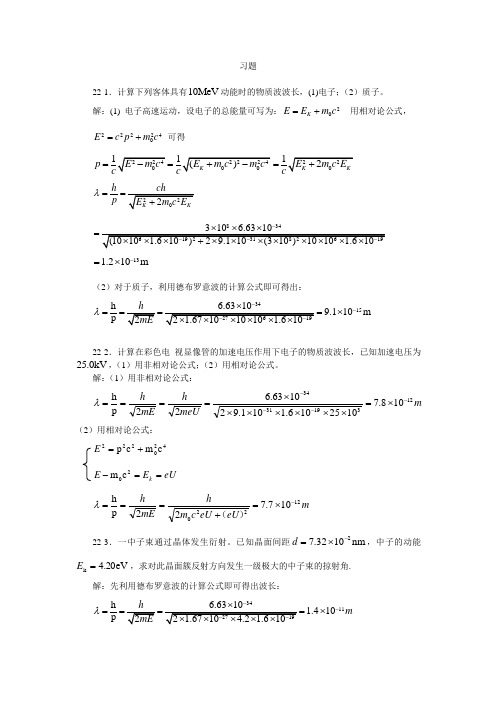
习题22-1.计算下列客体具有MeV 10动能时的物质波波长,(1)电子;(2)质子。
解:(1) 电子高速运动,设电子的总能量可写为:20K E E m c =+ 用相对论公式,222240E c p m c=+ 可得p ===h p λ==834-=131.210m -=⨯(2)对于质子,利用德布罗意波的计算公式即可得出:3415h 9.110m p λ--====⨯22-2.计算在彩色电 视显像管的加速电压作用下电子的物质波波长,已知加速电压为kV 0.25,(1)用非相对论公式;(2)用相对论公式。
解:(1)用非相对论公式:mmeU h mE h 123193134108.71025106.1101.921063.622p h ----⨯=⨯⨯⨯⨯⨯⨯⨯====λ(2)用相对论公式:420222c m c p +=EeU E E k ==-20c mm eU eU c m hmE h 12220107.722p h -⨯=+===)(λ22-3.一中子束通过晶体发生衍射。
已知晶面间距nm 1032.72-⨯=d ,中子的动能eV 20.4k =E ,求对此晶面簇反射方向发生一级极大的中子束的掠射角.解:先利用德布罗意波的计算公式即可得出波长:3411h 1.410m λ--====⨯再利用晶体衍射的公式,可得出:2sin d k ϕλ= 0,1,2k =…11111.410sin 0.095k λϕ--⨯=== , 5.48ϕ= 22-4.以速度m/s 1063⨯=v 运动的电子射入场强为5V/cm =E 的匀强电场中加速,为使电子波长A 1=λ,电子在此场中应该飞行多长的距离?解:3410h 110p m λ--====⨯ 可得:U=150.9V ,所以 U=Ed ,得出d=30.2cm 。
22-5.设电子的位置不确定度为A 1.0,计算它的动量的不确定度;若电子的能量约为keV 1,计算电子能量的不确定度。
大学物理量子物理
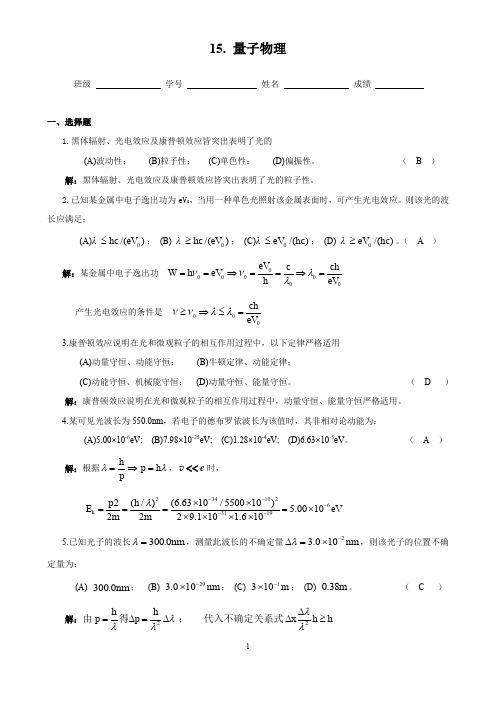
15. 量子物理班级 学号 姓名 成绩一、选择题1.黑体辐射、光电效应及康普顿效应皆突出表明了光的(A)波动性; (B)粒子性; (C)单色性; (D)偏振性。
( B )解:黑体辐射、光电效应及康普顿效应皆突出表明了光的粒子性。
2.已知某金属中电子逸出功为eV 0,当用一种单色光照射该金属表面时,可产生光电效应。
则该光的波长应满足:(A))/(0eV hc λ≤; (B) )/(0eV hc λ≥; (C))/(0hc eV λ≤; (D) )/(0hc eV λ≥。
( A )解:某金属中电子逸出功 0000000eV c ch W h eV h eV ννλλ==⇒==⇒= 产生光电效应的条件是 000ch eV ννλλ≥⇒≤= 3.康普顿效应说明在光和微观粒子的相互作用过程中,以下定律严格适用(A)动量守恒、动能守恒; (B)牛顿定律、动能定律;(C)动能守恒、机械能守恒; (D)动量守恒、能量守恒。
( D )解:康普顿效应说明在光和微观粒子的相互作用过程中,动量守恒、能量守恒严格适用。
4.某可见光波长为550.0nm ,若电子的德布罗依波长为该值时,其非相对论动能为:(A)5.00×10-6eV; (B)7.98×10-25eV; (C)1.28×10-4eV; (D)6.63×10-5eV 。
( A ) 解:根据h p h pλλ=⇒=,c <<v 时, 234102631192(/)(6.6310/550010) 5.0010eV 2229.110 1.610k p h E m m λ-----⨯⨯====⨯⨯⨯⨯⨯ 5.已知光子的波长nm 0.300=λ,测量此波长的不确定量nm 100.32-⨯=∆λ,则该光子的位置不确定量为:(A) nm 0.300; (B) nm 100.329-⨯; (C) m 1031-⨯; (D) m 38.0。
大学物理讲稿(第15章量子力学基础)

第15章 量子力学基础人们用经典物理解释黑体辐射、光电效应、氢原子光谱等实验规律时,遇到了不可克服的困难.经过不断的探索和研究,终于突破了经典物理的传统观念,建立起量子理论.量子理论和相对论是现代物理学的两大支柱.量子理论的诞生,对研究原子、电子、质子、光子等微观粒子的运动规律提供了正确的导向.从此使物理学发生了一次历史性的飞跃,促进了原子能、激光、超导、半导体等众多新技术的生产和发展.本章前部分,分别介绍黑体辐射、光电效应、氢原子光谱等实验规律以及为解释这些实验规律而提出的量子假设,即早期的量子论.本章的后部分简要介绍量子力学的基本概念及原理,并通过几个具体事例的讨论说明量子力学处理问题的一般方法.§15.1 黑体辐射与普朗克的量子假设一、黑体辐射的基本规律1 热辐射组成物体的分子中都包含着带电粒子,当分子作热运动时物体将会向外辐射电磁波,由于这种电磁波辐射与物体的温度有关,故称其为热辐射.实验表明,热辐射能谱是连续谱,发射的能量及其按波长的分布是随物体的温度而变化的.随着温度的升高,不仅辐射能在增大,而且辐射能的波长范围向短波区移动.物体在辐射电磁波的同时,也吸收投射到物体表面的电磁波.理论和实验表明,物体的辐射本领越大,其吸收本领也越大,反之亦然.当辐射和吸收达到平衡时,物体的温度不再变化而处于热平衡状态,这时的热辐射称为平衡热辐射.为描述物体热辐射能按波长的分布规律,引入单色辐射出射度(简称单色辐出度)这一物理量,其定义为:物体单位表面积在单位时间内发射的、波长在λ+λ→λd 范围内的辐射能dM λ与波长间隔d λ的比值,用M λ(T)表示,即λ=λλd dM T M )( (15.1) 而辐出度定义为⎰∞λλ=0d T M T M )()( (15.2) 2 黑体辐射的基本规律投射到物体表面的电磁波,可能被物体吸收,也可能被物体反射和透射.能够全部吸收各种波长的辐射能而完全不发生反射和透射的物体称为绝对黑体,简称黑体.绝对黑体是一种理想模型,实验室中用不透明材料制成带有小孔的空腔物体可近似看作黑体.图15.1为用实验方法测得的黑体单色辐出度M B λ (T)按波长和温度分布的曲线.关于黑体辐射,有两个基本定律:一个是斯特藩—玻耳兹曼定律(M B (T )=σT 4 ,即黑体的辐出度与其热力学温度的四次方成正比 ,其中σ=5.6705×10-8 W•m -2 • K -4 称为斯特藩—玻耳兹曼常数);另一个是维恩位移定律(λm T=b,即黑体单色辐出度的最大值对应的波长λm 与其绝对温度T 成反比,其中b=2.8978×10-3m •K 为与温度无关的常数).这两个定律在现代科学技术中有广泛的应用.通常用于测量高温物体(如冶炼炉、钢水、太阳或其他发光体等)温度的光测高温法就是在这两个定律的基础上建立起来的,同时,这两个定律也是遥感技术和红外跟踪技术的理论依据.从理论上导出绝对黑体单色辐出度与波长和温度的函数关系,即M Bλ=f(λ, T) ,是19世纪末期理论物理学面临的重大课题.维恩(W.Wien,1864—1928年)假定带电谐振子的能量按频率的分布类似于麦克斯韦速率分布率,然后用经典统计物理学方法导出了黑体辐射的下述公式T c B e c T M λ-λλ=/)(251 (15.3) 其中 和 是两个由实验确定的参数.上式称为维恩公式.维恩公式只是在短波波段与实验曲线相符,而在长波波段明显偏离实验曲线,如图15.2所示.瑞利(J.W.S.Rayleigh,1842—1919年)和金斯(J.H.Jeans,1877—1946年)根据经典电动力学和经典统计物理学导出了另一个力图反映绝对黑体单色辐出度与波长和温度关系的函数 42λπ=λckT T M B )( (15.4) 式中c 是真空中的光速,k 是玻耳兹曼常数.上式称为瑞利—金斯公式.该公式在长波波段与实验相符,但在短波波段与实验曲线有明显差异,如图15.2所示.这在物理学史上曾称为“紫外灾难”.234167895οοοοοοοοοοοοοο瑞利—金斯线 维恩线 普朗克线 能量密度 m/μ波长图15.2二、普朗克的量子假设1900年普朗克(M.Planck,1858—1947年)在综合了维恩公式和瑞利—金斯公式各自的成功之处以后,得到黑体的单色辐出度为)()(/11252-λπ=λλkT hc B e hc T M (15.5) 这就是普朗克公式,式中h 为普朗克常数,1986年的推荐值为 h=6.6260755×10-34 J ·s.普朗克公式与实验结果的惊人符合预示了其中包含着深刻的物理思想.普朗克指出,如果作下述假定,就可以从理论上导出他的黑体辐射公式:物体若发射或吸收频率为ν的电磁辐射,只能以ε=hν为单位进行,这个最小能量单位就是能量子,物体所发射或吸收的电磁辐射能量总是这个能量子的整数倍,即),,,(Λ321=ν=ε=n nh n E (15.6)普朗克的能量子思想是与经典物理学理论不相容的,也正是这一新思想,使物理学发生了划时代的变化,宣告了量子物理的诞生.普朗克也因此荣获1918年的诺贝尔物理学奖.作业(P224):23§15.2 光电效应与爱因斯坦的光量子假设普朗克的量子假设提出后的最初几年中,并未受到人们的重视,甚至普朗克本人也总是试图回到经典物理的轨道上去.最早认识普朗克假设重要意义的是爱因斯坦,他在1905年发展了普朗克的思想,提出了光子假设,成功的解释了光电效应的实验规律.一、光电效应的实验规律金属在光的照射下,有电子从表面逸出,这种现象称为光电效应.光电效应中逸出金属表面的电子称为光电子.光电子在电场的作用下所形成的电流叫光电流.研究光电效应的实验装置如图15.3所示.在一个抽空的玻璃泡内装有金属电极K(阴极)和A(阳极),当用适当频率的光从石英窗口射入照在阴极K 上时,便有光电子自其表面逸出,经电场加速后为阳极A 所吸收,形成光电流.改变电位差U AK ,测得光电流 i ,可得光电效应的伏安特性曲线,如图15.4所示.实验研究表明,光电效应有如下规律:1)阴极K 在单位时间内所发射的光电子数与照射光的强度成正比.从图15.4可以看出,光电流i 开始时随 增大而增大,而后就趋于一个饱和值 ,它与单位时间内从阴极K 发射的光子数成正比.所以单位时间内从阴极K 发射的光电子数与照射光强成正比.2)存在截止频率.实验表明,对一定的金属阴极,当照射光频率小于某个最小值i s 时,不管光强多大,都没有光电子逸出,这个最小频率v 0称为该种金属的光电效应截止频率,也叫红限,对应的波长0λ称为截止波长.每一种金属都有自己的红限.3)光电子的初动能与照射光的强度无关,而与其频率成线性关系.在保持光照射不变的情况下,改变电位差U AK ,发现当U AK =0时,仍有光电流.这显然是因为光电子逸出时就具有一定的初动能.改变电位差极性,使U AK <0 ,当反向电位差增大到一定值时,光电流才降为零,如图15.4所示.此时反向电位差的绝对值称为遏止电压,用U a 表示.不难看出,遏止电压与光电子的初动能间有如下关系a eU m =υ2021 (15.7) 式中m 和e 分别是电子的静质量和电量, 0υ是光电子逸出金属表面的最大速率. 实验还表明,遏止电压U a 与光强I 无关,而与照射光的频率v 成线性关系,即 0V K U a -ν= (15.8)式中K 和V 0都是正值,其中K 为普适恒量,对一切金属材料都是相同的,而V 0=Kv 0对同一种金属为一恒量,但对于不同的金属具有不同的数值.将式(15.8)代入式(15.7)得 )(002021ν-ν=-ν=υeK eV eK m (15.9) 上式表明,光电子的初动能与入射光的频率成线性关系,与入射光强无关.4)光电子是即时发射的,滞后时间不超过10-9s.实验表明,只要入射光的频率大于该金属的红限,当光照射这种金属表面时,几乎立即产生光电子,而无论光强多大.二、爱因斯坦光子假设和光电效应方程对于上述实验事实,经典物理学理论无法解释.按照光的波动理论,光波的能量由光强决定,在光照射下,束缚在金属内的“自由电子”将从入射光波中吸收能量而逸出表面,因而逸出光电子的初动能应由光强决定,但光电效应中光电子的初动能与光强无关;另外,如果光波供给金属中“自由电子”逸出表面所需的足够能量,光电效应对各种频率的光都能发生,不应该存在红限,而且,光电子从光波中吸收能量应有一个积累过程,光强越弱,发射光子所需要的时间就越长,这都与光电效应的实验事实相矛盾.由此可见,光的波动理论无法解释光电效应的实验规律.为了克服光的波动理论所遇到的困难,从理论上解释光电效应,爱因斯坦发展了普朗克能量子的假设,于1905年提出了如下的光子假设:一束光就是一束以光速运动的粒子流,这些粒子称为光量子(简称光子);频率为v 的光子所具有的能量为hv ,它不能再分割,而只能整个的被吸收或产生出来.按照光子理论,当频率为v 的光照射金属表面时,金属中的电子将吸收光子,获得 的能量,此能量的一部分用于电子逸出金属表面所需要的功(此功称为逸出功A);另一部分则转变为逸出电子的初动能.据能量守恒定律有(15.10) 这就是爱因斯坦的光电效应方程.)(002021ν-ν=-ν=υ↓eK eV eK m 比较 00eK νeV A eK,h === (15.11)由实验可测量K 和V 0,算出普朗克常数h 和逸出功A,进而还可求出金属的红限v 0.按照光子理论,照射光的光强就是单位时间到达被照物单位垂直表面积的能量,它是由单位时间到达单位垂直面积的光子数N 决定的.因此光强越大,光子数越多,逸出的光电子数就越多.所以饱和光电流与光强成正比;由于每一个电子从光波中得到的能量只与单个光子的能量hv 有关,所以光电子的初动能与入射光的频率成线性关系,与光强无关.当光子的能量hv 小于逸出功A,即入射光的频率v 小于红限v 0时,电子就不能从金属表面逸出;另外,光子与电子作用时,光子一次性将能量 全部传给电子,因而不需要时间积累,即光电效应是瞬时的.这样光子理论便成功地解释了光电效应的实验规律,爱因斯坦也因此获得1921年的诺贝尔物理学奖.例题15.1 用波长为400nm 的紫光去照射某种金属,观察到光电效应,同时测得遏止电压为1.24V ,试求该金属的红限和逸出功.解:由光电效应方程得逸出功为1.87eV J 102.9919=⨯=-=-=-020eU λc h m υ21h νA 根据红限与逸出功的关系,得红限为Hz 1051410626610992143419⨯=⨯⨯==--...h A ν0 三、光(电磁波)的波粒二象性一个理论若被实验证实,它必定具有一定的正确性.光子论被黑体辐射、光电效应以及其他实验所证实,说明它具有一定的正确性.而早已被大量实验证实了的光的波动论以及其他经典物理理论的正确性,也是无可非议的.因此,在对光的本性的解释上,不应该在光子论和波动论之间进行取舍,而应该把它们同样地看作是光的本性的不同侧面的描述.这就是说,光具有波和粒子这两方面的特性,这称为光的波粒二象性.既是粒子,也是波,这在人们的经典观念中是很难接受的.实际上,光已不是经典意义下的波,也不是经典意义下的粒子,而是波和粒子的统一.光是由具有一定能量、动量和质量的粒子组成的,在它们运动的过程中,在空间某处发现它们的几率却遵从波动的规律.描述光的粒子特征的能量与描述其波动特征的频率之间的关系为(15.12)由狭义相对论能量—动量关系并考虑光子的静质量为零得光子动量与波长的关系为====Ph Pc/h c E/h c νc λ (15.13) 它们通过普朗克常数紧密联系起来.通过质能关系还可得光子的质量为c P ch c E m 22=ν==作业(P224):26§15.3 氢原子光谱与玻尔的量子论经典物理学不仅在说明电磁辐射与物质相互作用方面遇到了如前所述的困难,而且在说明原子光谱的线状结构及原子本身的稳定性方面也遇到了不可克服的困难.丹麦物理学家玻尔发展了普朗克的量子假设和爱因斯坦的光子假设等,创立了关于氢原子结构的半经典量子理论,相当成功的说明了氢原子光谱的实验规律.一、氢原子光谱的实验规律实验发现,各种元素的原子光谱都由分立的谱线所组成,并且谱线的分布具有确定的规律.氢原子是最简单的原子,其光谱也是最简单的.对氢原子光谱的研究是进一步学习原子、分子光谱的基础,而后者在研究原子、分子结构及物质分析等方面有重要的意义.在可见光范围内容易观察到氢原子光谱的四条谱线,这四条谱线分别用H α、H β、H γ和H δ表示,如图15.5所示.1885年巴耳末(J.JBalmer,1825—1898)发现可以用简单的整数关系表示这四条谱线的波长6543,,,=-=n ,2n n B λ222(15.14) 式中B 是常数,其值等于364.57nm.后来实验上还观察到相当于n 为其他正整数的谱线,这些谱线连同上面的四条谱线,统称为氢原子的巴耳末系.光谱学上经常用波数 表示光谱线,它被定义为波长的倒数,即λ=ν1~(15.15) 引入波数后,式(15.14)可改写为Λ,,,),(~54312122=-=n n R ν (15.16) 式中172m 100967761B 2R -⨯==./,称为里德伯(J.R.Rydberg,1854—1919)常数.在氢原子光谱中,除了可见光范围的巴耳末线系以外,在紫外区、红外区和远红外区分别有赖曼(T.Lyman)系、帕邢(F.Paschen)系、布拉开(F.S.Brackett)系和普丰德(A.H.Pfund)系.这些线系中谱线的波数也都可以用与式(15.16)相似的形式表示.将其综合起来可表为)(~2211n k R T(n)T(k)νkn -=-= (15.17) 式中k 和n 取一系列有顺序的正整数,k 取1、2、3、4、5分别对应于赖曼线系、巴耳末线系、帕邢线系、布拉开线系和普丰德线系;一旦k 值取定后,n 将从k+1 开始取k+1, k+2, k+3等分别代表同一线系中的不同谱线. T(n)=R/n 2称为氢的光谱项.式(15.17)称为里德伯—里兹并合原理.实验表明,并合原理不仅适用于氢原子光谱,也适用于其他元素的原子光谱,只是光谱项的表示式要复杂一些.并合原理所表示的原子光谱的规律性,是原子结构性质的反映,但经典物理学理论无法予以解释.按照原子的有核模型,根据经典电磁理论,绕核运动的电子将辐射与其运动频率相同的电磁波,因而原子系统的能量将逐渐减少.随着能量的减少,电子运动轨道半径将不断减小;与此同时,电子运动的频率(因而辐射频率)将连续增大.因此原子光谱应是连续的带状光谱,并且最终电子将落到原子核上,因此不可能存在稳定的原子.这些结论显然与实验事实相矛盾,从而表明依据经典理论无法说明原子光谱规律等.二、玻尔的量子论玻尔(N.H.D.Bohr,1885—1962)把卢瑟福关于原子的有核模型、普朗克量子假设、里德伯—里兹并合原理等结合起来,于1913年创立了氢原子结构的半经典量子理论,使人们对于原子结构的认识向前推进了一大步.玻尔理论的基本假设是1)原子只能处在一系列具有不连续能量的稳定状态,简称定态,相应于定态,核外电子在一系列不连续的稳定圆轨道上运动,但并不辐射电磁波;2)作定态轨道运动的电子的角动量L 的数值只能是)/(π2h η的整数倍,即(15.18)这称为角动量量子化条件,n 称为主量子数,m 是电子的质量;3)当原子从一个能量为E k 的定态跃迁到另一个能量为E n 的定态时,会发射或吸收一个频率为v kn 的光子(15.19) 上式称为辐射频率公式, v kn >0表示向外辐射光子, v kn <0表示吸收光子.玻尔还认为,电子在半径为r 的定态圆轨道上以速率υ绕核作圆周运动时,向心力就是库仑力,因而有2202re πεr υm ⋅=41 (15.20) 由式(15.18)和式(15.20)消去υ,即可得原子处于第n 个定态时电子轨道半径为),,,()Λ321(1===n r n πme h εn r 22202n (15.21)对应于n=1的轨道半径r 1是氢原子的最小轨道半径,称为玻尔半径,常用a 0表示,其值为m 10291772495111-⨯===.2200πme h εr a (15.22) 这个数值与用其他方法得到的数值相符合.氢原子的能量应等于电子的动能与势能之和,即re πεr e πεm υE 20202⋅-=⋅-=814121 处在量子数为n 的定态时,能量为),,,()(Λ321n 81812n n =-=⋅-=220420h εme n r e πεE (15.23)由此可见,由于电子轨道角动量不能连续变化,氢原子的能量也只能取一系列不连续的值,这称为能量量子化,这种量子化的能量值称为原子的能级.式(15.23)是氢原子能级公式.通常氢原子处于能量最低的状态,这个状态称为基态,对应于主量子数n=1, E 1=-13.6 eV . n>1的各个稳定状态的能量均大于基态的能量,称为激发态,或受激态.处于激发态的原子会自动地跃迁到能量较低的激发态或基态,同时释放出一个能量等于两个状态能量差的光子,这就是原子发光的原理.随着量子数n 的增大,能量E n 也增大,能量间隔减小. 当n →∞时,rn →∞, E n →0 ,能级趋于连续,原子趋于电离. E > 0时,原子处于电离状态,能量可连续变化.图15.6和图15.7分别是氢原子处于各定态的电子轨道图和氢原子的能级图.使原子或分子电离所需要的能量称为电离能.根据玻尔理论算出的氢原子基态能量值与实验测得的氢原子基态电离能值13.6eV 相符.下面用玻尔理论来研究氢原子光谱的规律.按照玻尔假设,当原子从较高能态E n 向较低能态E k (n>k)跃迁时,发射一个光子,其频率和波数为1n =2n =3n =4n =1r r =14r r =19r r =116r r =赖曼系巴耳末系帕邢系 图15.6 氢原子定态的轨道图hE E νk n nk -= (15.24) )~k n nk nk nk E E hcc νλν-===(11 (15.25) 将能量表示式(15.23)代入即可得氢原子光谱的波数公式)()(~k n nk c h εme ν0nk >-=22324118 (15.26) 显然式(15.26)与氢原子光谱的经验公式(15.17)是一致的,同时可得里德伯常数的理论值为173204m 10097373118-⨯=ε=.ch me R H 理论 (15.27) 这也与实验值符合得很好.这表示玻尔理论在解释氢原子光谱的规律性方面是十分成功的,同时也说明这个理论在一定程度上反映了原子内部的运动规律.三、玻尔理论的缺陷和意义玻尔的半经典量子理论在说明光谱线规律方面取得了前所未有的成功.但是它也有很大的局限性,如只能计算氢原子和类氢离子的光谱线,对其他稍微复杂的原子就无能为力了;另外,它完全没有涉及谱线强度、宽度及偏振性等.从理论体系上讲,这个理论的根本问题在于它以经典理论为基础,但又生硬的加上与经典理论不相容的若干重要假设,如定态不辐射和量子化条件等,因此它远不是一个完善的理论.但是玻尔的理论第一次使光谱实验得到了理论上的说明,第一次指出经典理论不能完全适用于原子内部运动过程,揭示出微观体系特有的量子化规律.因此它是原子物理发展史上一个重要的里程碑,对于以后建立量子力学理论起到了巨大的推动作用.另外,玻尔理论在一些基本概念上,如“定态”、“能级”、“能级跃迁决定辐射频率”等在量子力学中仍是非常重要的基本概念,虽然另有一些概念,如轨道等已被证实对微观粒子不再适用.作业(P224):27§15.4 微观粒子的波—粒二象性 不确定关系一、微观粒子的波—粒二象性1923~1924年间,德布罗意仔细地分析了光的微粒说和波动说的历史,深入的研究了光子假设.他认为,19世纪以来,在光的研究中人们只重视了光的波动性,而忽视了它的粒子性.但在实物粒子的研究中却又发生了相反的情况,只重视实物粒子的粒子性,而忽略了它的波动性.在这种思想的支配下,德布罗意大胆的提出了物质的波—粒二象性假设.他认为,质量为m,速度为υ的自由粒子,一方面可用能量E 和动量p 来描述它的粒子性;另一方面还可用频率v 和波长λ来描述它的波动性.它们之间的关系与光的波—粒二相性所描述的关系一样,即h/p λE/h,ν== (15.28)式(15.28)叫德布罗意公式.这种和实物粒子相联系的波称为德布罗意波,或叫物质波.德布罗意因这一开创性工作而获得了1929年的诺贝尔物理学奖.由于自由粒子的能量和动量均为常量,所以与自由粒子相联系的波的频率和波长均不变,这说明与自由粒子相联系的德布罗意波可用平面波描述.对于静质量为m 0,速度为υ的实物粒子,其德布罗意波长为220/c υυm h p h λ-==1 (15.30) 德布罗意关于物质波的假设,1927年首先由戴维孙(C.J.Davisson,1881—1958)和革末(L.H.Germer,1896—1971)通过电子衍射实验所证实.戴维孙和革末作电子束在晶体表面散射实验时,观察到了和X 射线在晶体表面衍射相似的电子衍射现象,从而证实了电子具有波动性.当时的实验中,采用50KV 的电压加速电子,波长约为0.005nm.由于波长非常短,实验难度很高,因此这一实验是极其卓越的.后来证实了不仅电子具有波动性,其他微观粒子,如原子、质子和中子等也都具有波动性.微观粒子的波动性在现代科学技术上已得到广泛的应用,利用电子的波动性,已制造出了高分辨率的电子显微镜;利用中子的波动性,制成了中子摄谱仪.既然微观粒子具有波动性,原子中绕核运动的电子无疑也具有波动性.不过处于原子定态中的电子的波动形式,与戴维孙和革末实验中由小孔衍射的电子束的波动形式是不同的,后者可认为是行波,而前者则应看为驻波.处于定态中的电子形成驻波的情形,与端点固定的振动弦线形成驻波的情形是相似的.原子中电子驻波可如图15.8形象地表示.由图可见,当电子波在离开原子核为r 的圆周上形成驻波时,圆周长必定等于电子波长的整数倍,即),,,(Λ3212==n n λπr (15.31)利用德布罗意关系便可得电子的轨道角动量应满足下面的关系),,,(Λη3212====n n λh πλn rP L (15.32) 这正是玻尔作为假设引入的量子化条件,在这里,考虑了微观粒子的波动性就自然的得出了量子化条件.例题15.2 计算经过电势差U=150V 和U=104V 加速的电子的德布罗意波长(在U<104V 时,可不考虑相对论效应).解:忽略相对论效应,经过电势差U 加速后,电子的动能和速率分别为202,21m eU eU υm =υ= 式中m 0为电子的静止质量.利用德布罗意关系可得德布罗意波长nm 11.225m 1102512121000UU U e m h υm h λ=⨯=⋅==-. 式中U 的单位是伏特. 1nm 0150V U 11.=λ→=,0.0123nm V 10U 242=λ→=由此可见,在这样的电压下,电子的德布罗意波长与X 射线的波长相近。
量子力学第五章全同粒子

第五章:全同粒子
杨焕雄
中国科学技术大学物理学院近代物理系 hyang@
November 25, 2019
1 / 23
双粒子体系:
单粒子量子力学体系的状态用波函数 p~r; s3; tq 描写:
p~r; s3; tq 是粒子空间位置坐标~r,自旋角动量 s3 以及
时间参数 t 的函数.
考虑 N 个全同粒子组成的多粒子体系,设其量子态用波函数
Ψpq1; ¨ ¨ ¨ ; qi; ¨ ¨ ¨ ; qj; ¨ ¨ ¨ ; qNq 描写, qi(i “ 1; 2; ¨ ¨ ¨ ; N)代表第 i 个粒子的全部坐标(例如
包括空间坐标与自旋). 设 Pˆij 表示交换第 i 个粒子与第 j 个粒子 的全部坐标的线性算符:
PˆijΨpq1; ¨ ¨ ¨ ; qi; ¨ ¨ ¨ ; qj; ¨ ¨ ¨ ; qNq “ Ψpq1; ¨ ¨ ¨ ; qj; ¨ ¨ ¨ ; qi; ¨ ¨ ¨ ; qNq
粒子的全同性意味着 Ψ 与 PˆijΨ 描写的是同一个量子态,它们最 多可以相差一个非零的常数因子 c,
PˆijΨ “ c Ψ
8 / 23
两端再作用一次 Pˆij,得:
Ψ “ Pˆ2ijΨ “ c PˆijΨ “ c2 Ψ;
ù c2 “ 1; c “ ˘1
所以,全同粒子体系的波函数必须满足下列关系之一:或者关于 交换任意两个粒子对称:
PˆijΨ “ Ψ
或者关于交换任意两个粒子反对称:
PˆijΨ “ ´Ψ
迄今一切实验表明,全同粒子体系的波函数的交换对称性与粒子 的自旋角动量有密切的关系:
s13 ;s23
›
›
以下仅考虑有效势能不显含时间的情形. 此时,通过分离变 量可求得薛定谔方程一组完备的特解:
2024版《大学物理》全套教学课件(共11章完整版)

01课程介绍与教学目标Chapter《大学物理》课程简介0102教学目标与要求教学目标教学要求教材及参考书目教材参考书目《普通物理学教程》(力学、热学、电磁学、光学、近代物理学),高等教育出版社;《费曼物理学讲义》,上海科学技术出版社等。
02力学基础Chapter质点运动学位置矢量与位移运动学方程位置矢量的定义、位移的计算、标量与矢量一维运动学方程、二维运动学方程、三维运动学方程质点的基本概念速度与加速度圆周运动定义、特点、适用条件速度的定义、加速度的定义、速度与加速度的关系圆周运动的描述、角速度、线速度、向心加速度01020304惯性定律、惯性系与非惯性系牛顿第一定律动量定理的推导、质点系的牛顿第二定律牛顿第二定律作用力和反作用力、牛顿第三定律的应用牛顿第三定律万有引力定律的表述、引力常量的测定万有引力定律牛顿运动定律动量定理角动量定理碰撞030201动量定理与角动量定理功和能功的定义及计算动能定理势能机械能守恒定律03热学基础Chapter1 2 3温度的定义和单位热量与内能热力学第零定律温度与热量热力学第一定律的表述功与热量的关系热力学第一定律的应用热力学第二定律的表述01熵的概念02热力学第二定律的应用03熵与熵增原理熵增原理的表述熵与热力学第二定律的关系熵增原理的应用04电磁学基础Chapter静电场电荷与库仑定律电场与电场强度电势与电势差静电场中的导体与电介质01020304电流与电流密度磁场对电流的作用力磁场与磁感应强度磁介质与磁化强度稳恒电流与磁场阐述法拉第电磁感应定律的表达式和应用,分析感应电动势的产生条件和计算方法。
法拉第电磁感应定律楞次定律与自感现象互感与变压器电磁感应的能量守恒与转化解释楞次定律的含义和应用,分析自感现象的产生原因和影响因素。
介绍互感的概念、计算方法以及变压器的工作原理和应用。
分析电磁感应过程中的能量守恒与转化关系,以及焦耳热的计算方法。
电磁感应现象电磁波的产生与传播麦克斯韦方程组电磁波的辐射与散射电磁波谱与光子概念麦克斯韦电磁场理论05光学基础Chapter01光线、光束和波面的概念020304光的直线传播定律光的反射定律和折射定律透镜成像原理及作图方法几何光学基本原理波动光学基础概念01020304干涉现象及其应用薄膜干涉及其应用(如牛顿环、劈尖干涉等)01020304惠更斯-菲涅尔原理单缝衍射和圆孔衍射光栅衍射及其应用X射线衍射及晶体结构分析衍射现象及其应用06量子物理基础Chapter02030401黑体辐射与普朗克量子假设黑体辐射实验与经典物理的矛盾普朗克量子假设的提普朗克公式及其物理意义量子化概念在解决黑体辐射问题中的应用010204光电效应与爱因斯坦光子理论光电效应实验现象与经典理论的矛盾爱因斯坦光子理论的提光电效应方程及其物理意义光子概念在解释光电效应中的应用03康普顿效应及德布罗意波概念康普顿散射实验现象与经德布罗意波概念的提典理论的矛盾测不准关系及量子力学简介测不准关系的提出及其物理量子力学的基本概念与原理意义07相对论基础Chapter狭义相对论基本原理相对性原理光速不变原理质能关系广义相对论简介等效原理在局部区域内,无法区分均匀引力场和加速参照系。
大学物理(15.5.2)--德布罗意波实物粒子的波粒二象性
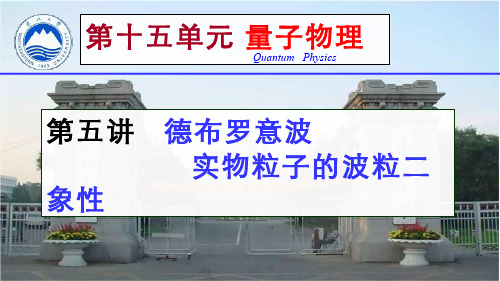
第十五单元 量子物理第十五单元 量子物理Quantum PhysicsQuantum Physics第五讲 德布罗意波实物粒子的波粒二象性1923年, 提出电子既具有粒子性又具有波动性, 1924年在他的博士论文《关于量子理论的研究》中提出把粒子性和波动性统一起来。
为量子力学的建立提供了物理基础。
他的论述被爱因斯坦誉为 “揭开了巨大面罩的一角”。
德布罗意为此获得1929年诺贝尔物理学奖。
一、背景1、Planck-Einstein光量子理论量子理论是首先在黑体辐射问题上突破的,Planck提出了能量子的概念;Einstein利用能量子假设提出了光量子的概念,从而解决了光电效应的问题;光量子概念在Compton散射实验中得到了直接的验证。
2、Bohr的量子论Bohr把Planck-Einstein的量子概念创造性的用来解决原子结构和原子光谱的问题,成功地解释了氢原子光谱。
“同我(Louis Victor de Broglie)哥哥进行的这些长期讨论……对我非常有益,这些讨论使我深深考虑将波的观点和粒子的观点必须综合在一起的必要性。
”光的本性:(1905年,爱因斯坦)光同时具有波动性和粒子性,波粒二象性的联系:νεh =λh p = 波长、频率是描写波动性的物理量,而动量、能量是描写粒子性的物理量。
光的波动性和粒子性是通过普朗克常数联系在一起的。
●很早认识到光的波动性;●直到1905年认识到光的粒子性。
光: 物理学家十分看重自然界的和谐和对称,运用对称性思想研究性问题,发现新规律以至于在科学上取得突破性成就,在物理学史上屡见不鲜。
问题: 实物粒子:●实物粒子是否也有波动性?●很早认识到实物粒子的粒子性;(经典物理)“整个世纪以来,在辐射理论上,比起波动的研究方法来,是过于忽略了粒子的研究方法;在实物理论上,是否发生了相反的错误呢?是不是我们关于‘粒子’的图像想得太多,而过分地忽略了波的图像呢?”“我我我我我我我我我我我我我我我我我我我我我我1923我我我—我我我我我我我我我我我我我我我我我我我我我我我我我我我我我我我我我我我”这种和实物粒子相联系的波称为德布罗意波或物质波(matter wave ) , 1924年 ,青年博士研究生德布罗意 ,在Planck-Einstein 光量子论和Bohr 原子论的启发下,仔细分析了光的微粒说与波动说的发展历史,根据类比的方法,德布罗意假设:不仅光具有波粒二象性,一切实物粒子(电子、原子、分子等)也都具有波粒二象性; 具有确定动量 P 和确定能量 E 的实物粒子相当于频率为ν和波长为λ的波,满足:hνmc E ==2λh m p ==v P Eλνh爱因斯坦的支持 :德布罗意的物质波开始并没有受到物理学界的重视,他的导师朗之万将论文寄给了爱因斯坦。
大学物理下量子力学基础05课件

由归一化条件: a Asin2 ( n x )dx 1
0
a
A 2 a
一维无限深方势阱中运动的粒子其波函数:
n (x) 0,
n (x)
A sin( nx ),
a
x 0, x a n 1,2,3, 0 x a
称n为量子数;n (x) 为本征态;En 为本征能量。
波函数回顾:
1、
是一个复指数函数,本身无物理意义
2、波函数模的平方 | |2 * 代表时刻 t ,在
r 处粒子出现的几率密度。
3、 | |2 d t时刻,在 (x,y,z) 处体积元d 内
粒子出现的几率。
4、波函数的标准化条件
5、波函数归一化条件:
§10.8 薛定谔方程
1、薛定谔方程建立应满足的条件
对应的几率密度与时间无关。即:
(r,t) (r,t) (r)(r)
处于定态下的粒子具有确定的能量E,粒子在空间的概
率密度分布不随时间变化,而且力学量的测量值的几率分 布和平均值都不随时间变化。
量子力学的处理方法
(1)已知粒子的m,势能函数V,即可给出薛定谔方程 (2)由给定的初、边值条件,求出波函数 (3)由波函数给出不同地点、时刻粒子的几率密度||2
(x) Asin nπ x
a n
(x) 2 2 sin2 nπ x
aa n 2
n4
16 E1
n3
n2 n 1
x0 a 2
a x0 a 2
9 E1
4 E1
a E1
Ep 0
2、 势垒贯穿(隧道效应)
V
V (x) 0, x 0, x a
V0
大学物理第13章 量子物理
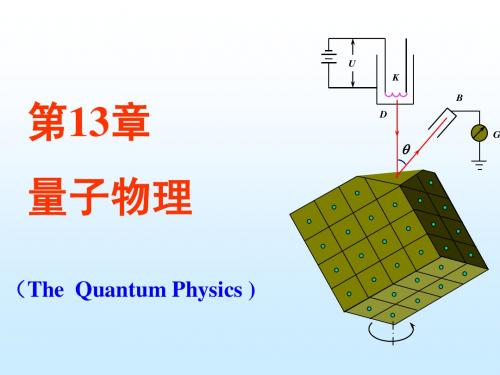
5
在短波区, 很小 普朗克公式 →维恩公式
,T
2hc
2
,T
2 hc 2
1 ehc / kT 1
5
5
e
x
hc ,
e
hc kT
x 1
hc 1 kT
普朗克公式 →瑞利-金斯公式
( , T )
实验
维恩公式 T=1646k
,T c1 e
5 c2 / T
其中c1,c2 为常量。
高频段与实验符合很好,低频段明显偏离实 验曲线。
瑞利— 金斯公式
( , T )
实验 瑞利-琼斯
1900年6月,瑞利按经 典的能量均分定理, 把空腔中简谐振子平 均能量取与温度成正 比的连续值,得到一 个黑体辐射公式
能量子概念的提出标志了量子力学的诞生,普 朗克为此获得1918年诺贝尔物理学奖。
2. 黑体辐射的两个定律: 斯特藩 — 玻耳兹曼定律
M (T ) T 4
5.67 10 w/m K —— 斯特藩 — 玻耳兹曼常量
2 4 8
1879年斯特藩从实验上总结而得 1884年玻耳兹曼从理论上证明
要求自学光电效应的实验规律和经典波动理 论的困难。
实验规律 (特点): ① 光强 I 对饱和光电流 im的影响: 在 一定时, m I 。 i
② 频率的影响:
截止电压 U c K U 0 与 光强I 无关;
U0 。 存在红限频率 0 K
③ 光电转换时间极短 <10-9s 。 2、波动理论的困难:不能解释以上②、 ③
1 1 R 2 2 n 1 1 n 2, 3,4, n 4,5,6,
大学物理(第四版)课后习题及答案_量子物理
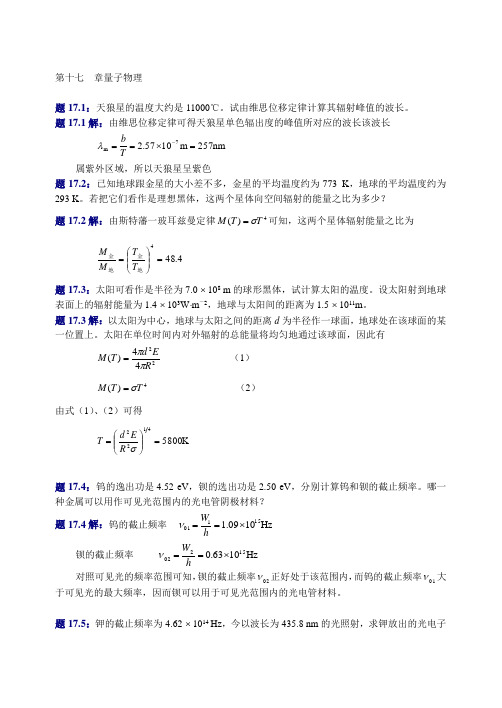
第十七 章量子物理题17.1:天狼星的温度大约是11000℃。
试由维思位移定律计算其辐射峰值的波长。
题17.1解:由维思位移定律可得天狼星单色辐出度的峰值所对应的波长该波长nm 257m 1057.27m =⨯==-Tbλ 属紫外区域,所以天狼星呈紫色题17.2:已知地球跟金星的大小差不多,金星的平均温度约为773 K ,地球的平均温度约为293 K 。
若把它们看作是理想黑体,这两个星体向空间辐射的能量之比为多少?题17.2解:由斯特藩一玻耳兹曼定律4)(T T M σ=可知,这两个星体辐射能量之比为4.484=⎪⎪⎭⎫⎝⎛=地金地金T T M M 题17.3:太阳可看作是半径为7.0 ⨯ 108 m 的球形黑体,试计算太阳的温度。
设太阳射到地球表面上的辐射能量为1.4 ⨯ 103W ⋅m -2,地球与太阳间的距离为1.5 ⨯ 1011m 。
题17.3解:以太阳为中心,地球与太阳之间的距离d 为半径作一球面,地球处在该球面的某一位置上。
太阳在单位时间内对外辐射的总能量将均匀地通过该球面,因此有 2244)(R Ed T M ππ=(1)4)(T T M σ= (2)由式(1)、(2)可得K 5800122=⎪⎪⎭⎫⎝⎛=σR E d T题17.4:钨的逸出功是4.52 eV ,钡的选出功是2.50 eV ,分别计算钨和钡的截止频率。
哪一种金属可以用作可见光范围内的光电管阴极材料?题17.4解:钨的截止频率 Hz 1009.115101⨯==hW ν 钡的截止频率Hz 1063.015202⨯==hW ν 对照可见光的频率范围可知,钡的截止频率02ν正好处于该范围内,而钨的截止频率01ν大于可见光的最大频率,因而钡可以用于可见光范围内的光电管材料。
题17.5:钾的截止频率为4.62 ⨯ 1014 Hz ,今以波长为435.8 nm 的光照射,求钾放出的光电子的初速度。
题17.5解:根据光电效应的爱因斯坦方程W mv h +=221ν 其中λνν/0c h W ==, 可得电子的初速度15210s m 1074.52-⋅⨯=⎥⎦⎤⎢⎣⎡⎪⎭⎫ ⎝⎛-=νλc m h v由于选出金属的电子的速度v << c ,故式中m 取电子的静止质量。
大学物理知识总结习题答案(第十章)量子物理基础
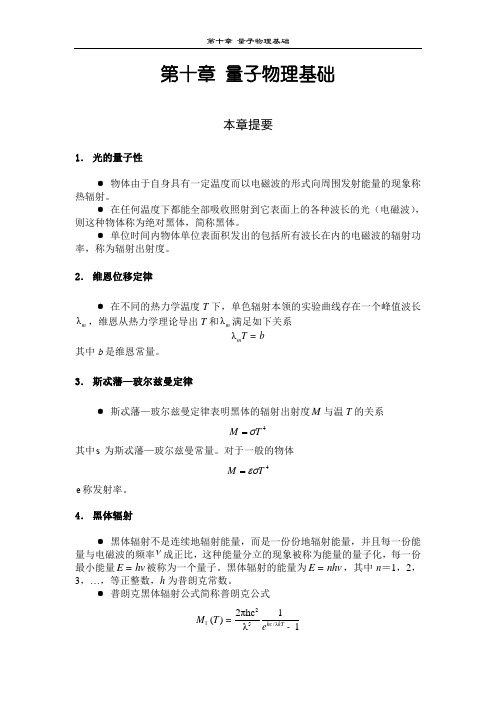
第十章 量子物理基础本章提要1. 光的量子性· 物体由于自身具有一定温度而以电磁波的形式向周围发射能量的现象称热辐射。
· 在任何温度下都能全部吸收照射到它表面上的各种波长的光(电磁波),则这种物体称为绝对黑体,简称黑体。
· 单位时间内物体单位表面积发出的包括所有波长在内的电磁波的辐射功率,称为辐射出射度。
2. 维恩位移定律· 在不同的热力学温度T 下,单色辐射本领的实验曲线存在一个峰值波长λm ,维恩从热力学理论导出T 和λm 满足如下关系λm T b =其中b 是维恩常量。
3. 斯忒藩—玻尔兹曼定律· 斯忒藩—玻尔兹曼定律表明黑体的辐射出射度M 与温T 的关系4T M σ=其中s 为斯忒藩—玻尔兹曼常量。
对于一般的物体4T M εσ=e 称发射率。
4. 黑体辐射· 黑体辐射不是连续地辐射能量,而是一份份地辐射能量,并且每一份能量与电磁波的频率ν成正比,这种能量分立的现象被称为能量的量子化,每一份最小能量E hv =被称为一个量子。
黑体辐射的能量为E nhv =,其中n =1,2,3,…,等正整数,h 为普朗克常数。
· 普朗克黑体辐射公式简称普朗克公式25/λ2πhc 1()λ1hc kT M T e l =-· 光是以光速运动的粒子流,这些粒子称为光量子,简称光子。
· 一个光子具有的能量为νh E =。
5. 粒子的波动性· 德布罗意认为实物粒子也具有波粒二象性,它的能量E 、动量p 跟和它相联系的波的频率ν、波长λ满足以下关系2E mc h ν==λh p m u == 这两个公式称为德布罗意公式或德布罗意假设。
与实物粒子相联系的波称为物质波或德布罗意波。
· x x p D D ?h 或者E t D D ?h 这一关系叫做不确定关系。
其中为位置不确定量、动量不确定量、能量不确定量、时间不确定量。
大学物理学(下册)第15章 量子物理基础

5、爱因斯坦的光子假说和光电效应方程
1).爱因斯坦光子假设 ①.光是一束以光速c运动的粒子流,这些粒子称为光子;
②.光子的能量: h
③.光的强度: SNh
2).爱因斯坦光电效应方程
爱因斯坦认为:在光电效应中,金属中的电子吸收
一个光子的能量h,一部分消耗在使金属中电子挣脱原子
2020/12/10
2. 普朗克理论与经典理论不同
经典理论的基本观点
普朗克能量子假设
(1)电磁波辐射来源于 带电粒子的振动,电磁波 频率与带电粒子振动频率 相同。 (2)振子辐射电磁波含 各种波长,是连续的,辐 射能量也是连续的。
对于频率为的振子,
振子辐射的能量不是 连续的,而是分立的, 它的取值是某一最小 能量 的整数倍
出的、在波长 附近单位波长间隔内的能量。称为单色辐
射出射度或单色辐出度。
M(T)
dM(T)
d
单位: W / m 3
2020/12/10
温度为 T 的物体,在单位时间内,从单位面积上所辐射
出的各种波长的电磁波的能量总和。称为辐射出射度或辐
出度。
M(T) 0M(T)d
单位: W / m 2
太阳和钨丝的单色 辐出度曲线
即:光电子的最大初动能与入射光的强度成正比关系,而 与光的频率无关。与实验结果不符。
2020/12/10
红限问题
按上述理论,无论何种频率的入射光,只要其强 度足够大,就能使电子具有足够的能量逸出金属,不 存在红限问题。与实验结果不符。
驰豫时间
按上述理论,如果入射光强很弱,则电子逸出金 属所需的能量,需要有一定的时间来积累。与实验结 果不符。
光的波动性用光波的波长 和频率 描述,光
大学物理量子力学总结(范本)
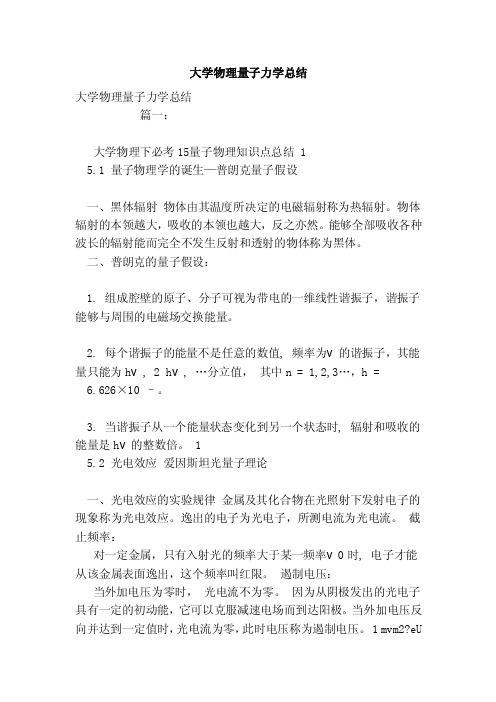
大学物理量子力学总结大学物理量子力学总结篇一:大学物理下必考15量子物理知识点总结15.1 量子物理学的诞生—普朗克量子假设一、黑体辐射物体由其温度所决定的电磁辐射称为热辐射。
物体辐射的本领越大,吸收的本领也越大,反之亦然。
能够全部吸收各种波长的辐射能而完全不发生反射和透射的物体称为黑体。
二、普朗克的量子假设:1. 组成腔壁的原子、分子可视为带电的一维线性谐振子,谐振子能够与周围的电磁场交换能量。
2. 每个谐振子的能量不是任意的数值, 频率为ν的谐振子,其能量只能为hν, 2hν, …分立值,其中n = 1,2,3…,h =6.626×10 –。
3. 当谐振子从一个能量状态变化到另一个状态时,辐射和吸收的能量是hν的整数倍。
15.2 光电效应爱因斯坦光量子理论一、光电效应的实验规律金属及其化合物在光照射下发射电子的现象称为光电效应。
逸出的电子为光电子,所测电流为光电流。
截止频率:对一定金属,只有入射光的频率大于某一频率ν0时, 电子才能从该金属表面逸出,这个频率叫红限。
遏制电压:当外加电压为零时,光电流不为零。
因为从阴极发出的光电子具有一定的初动能,它可以克服减速电场而到达阳极。
当外加电压反向并达到一定值时,光电流为零,此时电压称为遏制电压。
1 mvm2?eU2二、爱因斯坦光子假说和光电效应方程1. 光子假说一束光是一束以光速运动的粒子流,这些粒子称为光子;频率为v 的每一个光子所具有的能量为??h?, 它不能再分割,只能整个地被吸收或产生出来。
2. 光电效应方程根据能量守恒定律, 当金属中一个电子从入射光中吸收一个光子后,获得能量hv,如果hv 大于该金属的电子逸出功A,这个电子就能从金属中逸出,并且有 1上式为爱因斯坦光电效应方程,式中mvm2为光电子的最大初动能。
大学物理(第四版)课后习题及答案 量子物理

第十七 章量子物理题17.1:天狼星的温度大约是11000℃。
试由维思位移定律计算其辐射峰值的波长。
题17.1解:由维思位移定律可得天狼星单色辐出度的峰值所对应的波长该波长nm 257m 1057.27m =⨯==-Tbλ 属紫外区域,所以天狼星呈紫色题17.2:已知地球跟金星的大小差不多,金星的平均温度约为773 K ,地球的平均温度约为293 K 。
若把它们看作是理想黑体,这两个星体向空间辐射的能量之比为多少?题17.2解:由斯特藩一玻耳兹曼定律4)(T T M σ=可知,这两个星体辐射能量之比为4.484=⎪⎪⎭⎫⎝⎛=地金地金T T M M 题17.3:太阳可看作是半径为7.0 ⨯ 108 m 的球形黑体,试计算太阳的温度。
设太阳射到地球表面上的辐射能量为1.4 ⨯ 103W ⋅m -2,地球与太阳间的距离为1.5 ⨯ 1011m 。
题17.3解:以太阳为中心,地球与太阳之间的距离d 为半径作一球面,地球处在该球面的某一位置上。
太阳在单位时间内对外辐射的总能量将均匀地通过该球面,因此有 2244)(R Ed T M ππ=(1)4)(T T M σ= (2)由式(1)、(2)可得K 58004122=⎪⎪⎭⎫⎝⎛=σR E d T题17.4:钨的逸出功是4.52 eV ,钡的选出功是2.50 eV ,分别计算钨和钡的截止频率。
哪一种金属可以用作可见光范围内的光电管阴极材料?题17.4解:钨的截止频率 Hz 1009.115101⨯==hW ν 钡的截止频率Hz 1063.015202⨯==hW ν 对照可见光的频率范围可知,钡的截止频率02ν正好处于该范围内,而钨的截止频率01ν大于可见光的最大频率,因而钡可以用于可见光范围内的光电管材料。
题17.5:钾的截止频率为4.62 ⨯ 1014 Hz ,今以波长为435.8 nm 的光照射,求钾放出的光电子的初速度。
题17.5解:根据光电效应的爱因斯坦方程W mv h +=221ν 其中λνν/0c h W ==,可得电子的初速度15210s m 1074.52-⋅⨯=⎥⎦⎤⎢⎣⎡⎪⎭⎫ ⎝⎛-=νλc m h v由于选出金属的电子的速度v << c ,故式中m 取电子的静止质量。
大学mooc大学物理-相对论和量子物理章节测验期末考试答案
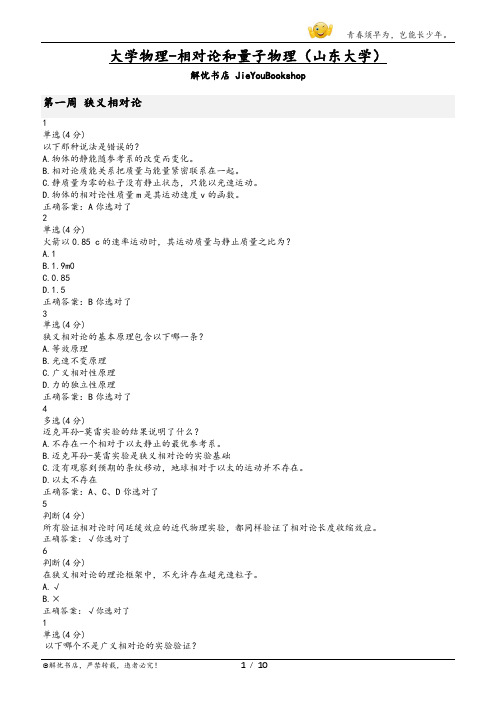
解忧书店 JieYouBookshop第一周狭义相对论1单选(4分)以下那种说法是错误的?A.物体的静能随参考系的改变而变化。
B.相对论质能关系把质量与能量紧密联系在一起。
C.静质量为零的粒子没有静止状态,只能以光速运动。
D.物体的相对论性质量m是其运动速度v的函数。
正确答案:A你选对了2单选(4分)火箭以0.85 c的速率运动时,其运动质量与静止质量之比为?A.1B.1.9m0C.0.85D.1.5正确答案:B你选对了3单选(4分)狭义相对论的基本原理包含以下哪一条?A.等效原理B.光速不变原理C.广义相对性原理D.力的独立性原理正确答案:B你选对了4多选(4分)迈克耳孙-莫雷实验的结果说明了什么?A.不存在一个相对于以太静止的最优参考系。
B.迈克耳孙-莫雷实验是狭义相对论的实验基础C.没有观察到预期的条纹移动,地球相对于以太的运动并不存在。
D.以太不存在正确答案:A、C、D你选对了5判断(4分)所有验证相对论时间延缓效应的近代物理实验,都同样验证了相对论长度收缩效应。
正确答案:√你选对了6判断(4分)在狭义相对论的理论框架中,不允许存在超光速粒子。
A.√B.×正确答案:√你选对了1单选(4分)以下哪个不是广义相对论的实验验证?B.水星近日点的进动C.雷达回波时间延迟实验D.密立根油滴实验正确答案:D你选对了2单选(4分)以下那种说法是错误的?A.相对论能量-动量关系指出了静质量为零的粒子存在的可能性。
B.静质量为零的粒子没有静止状态,只能以光速运动。
C.相对论质能关系把质量与能量紧密联系在一起。
D.物体的静质量m0是在静止的惯性系中测到的物体质量。
正确答案:D你选对了3单选(4分)狭义相对论的基本原理包含以下哪一条?A.等效原理B.功能原理C.相对性原理D.伽利略相对性原理正确答案:C你选对了第二周量子物理基础11单选(4分)以下哪种说法是错误的?A.康普顿效应反映了光具有波动性。
大学物理课程简介07

07000022、课程名称大学物理 ACollege Physics A3、授课对象理科非物理类、电子信息类、医科类(8年制)及工科强物理类本科各专业学生4、学分8 (144学时)5、修读期:第2、3学期6、课程负责人:徐斌富邹勇章可钦潘传芳7、课程简介大学物理课程在为学生较系统地打好必要的物理基础,培养学生现代的科学的自然观、宇宙观和辩证唯物主义世界观,培养学生的探索、创新精神,培养学生的科学思维能力,掌握科学方法等方面,都具有其他课程不能替代的重要作用。
本课程主要内容为:(1)力学---质点运动学、质点动力学、非惯性系和惯性力;刚体力学基础、刚体的平面运动、进动; 理想液体的性质、伯努利方程;简谐振动、阻尼振动、受迫振动和共振;波动学基础、超声波和次声波;相对论基础、迈克耳孙-莫雷实验; (2)热学--热力学基本定律、典型的热力学过程、多方过程;统计规律、能量按自由度均分定理;麦克斯韦速率分布律、输运现象。
(3)电磁学---库仑定律;毕奥—萨伐尔定律;电、磁场叠加原理、静电场和恒定磁场的高斯定理、环路定理;安培定律、电介质、磁介质;法拉第电磁感应定律;麦克斯韦方程组;电磁波的产生及基本性质;直流电与交流电; (4)光学---光的干涉、衍射和偏振; 迈克耳孙干涉仪; 全息照相; 光的双折射现象、偏振光干涉;(5)量子物理基础---辐射与物质的相互作用过程;物质波、薛定谔方程;电子隧道显微镜;一维谐振子; 原子的壳层结构、元素周期表等通过大学物理A课程的教学,使学生对物理学的基本概念、基础理论、基本方法有比较全面和系统的认识和正确的理解,为进一步专业学习打下坚实的基础;对物理学研究方法的运用、科学思维能力、技术能力、分析问题和解决问题的能力有较明显的提高, 从而提高学生的科学素质和创新能力。
努力实现知识、能力、素质的协调发展。
8. 实践环节与内容或辅助学习活动另开设大学物理实验。
9、课程考核成绩1(15%):期中考试, 成绩2(15%):平时作业, 成绩3(10%):任课教师自主考核项目, 成绩4(60%):期末考试10、指定教材《大学基础物理》(第一、二、三册)主编徐斌富等科学出版社2007年11、参考书目《物理学基础》[美]哈里德等著张三慧李椿等译机械工业出版社2005年(原书第6版)《新概念物理教程》赵凯华罗尉茵编高等教育出版社《大学物理学》张三慧主编清华大学出版社1999年第二版《大学基础物理学习指导》主编徐斌富等科学出版社2007年07000022、课程名称大学物理 BCollege Physics B3、授课对象工科类本科各专业学生4、学分 6 (108学时)5、修读期第2、3学期6、课程负责人: 徐斌富邹勇章可钦潘传芳7、课程简介大学物理课程在为学生较系统地打好必要的物理基础,培养学生现代的科学的自然观、宇宙观和辩证唯物主义世界观,培养学生的探索、创新精神,培养学生的科学思维能力,掌握科学方法等方面,都具有其他课程不能替代的重要作用。
大学物理公式总结(二)2024

大学物理公式总结(二)引言:大学物理公式总结(二)旨在整理和总结大学物理中重要的公式,帮助学生系统学习和复习物理知识。
本文将从五个大点出发,详细介绍这些公式的应用和推导。
正文:一、力学1. 牛顿第二定律- 描述了物体受力产生的加速度,公式为F=ma。
- 推导过程包括从牛顿第一定律推得第二定律以及应用牛顿第二定律解决动力学问题。
2. 动能定理- 描述了物体动能的变化与物体受力之间的关系,公式为ΔK=W。
- 证明过程包括力的功的定义和计算。
3. 动量定理- 描述了物体动量的变化与物体受力之间的关系,公式为Δp=F Δt。
- 推导过程包括牛顿第二定律与加速度的关系以及应用动量定理解决动量守恒问题。
4. 弹性碰撞- 描述了在碰撞过程中动能守恒和动量守恒的应用,公式包括动能守恒公式和动量守恒公式。
- 推导过程包括动能守恒与动量守恒的推导及应用。
5. 万有引力定律- 描述了质点之间存在引力的力学规律,公式为F=G(m1m2)/r²。
- 证明过程包括万有引力定律的推导和应用。
二、热学1. 热力学第一定律- 描述了物质热的增加等于对物体做的功与传递给物体的热量之和,公式为ΔU=Q-W。
- 证明过程包括内能的定义和计算。
2. 理想气体状态方程- 描述了理想气体的状态与压强、体积和温度之间的关系,公式为PV=nRT。
- 推导过程包括气体微观运动理论和状态方程的推导。
3. 热传导定律- 描述了热量在不同物体之间传递的规律,公式为Q=ksAT/Δx。
- 推导过程包括传热的基本原理和推导。
4. 热容定律- 描述了物体在升温或降温时吸收或释放的热量,公式为Q=mc ΔT。
- 证明过程包括热容的定义和计算。
5. 热力学第二定律- 描述了自然界中热量自发从高温物体传递到低温物体的不可逆性,公式为ΔS=Q/T。
- 证明过程包括熵的定义和计算。
三、电磁学1. 库仑定律- 描述了两个带电体之间电力的大小与距离的关系,公式为F=k(q1q2)/r²。
- 1、下载文档前请自行甄别文档内容的完整性,平台不提供额外的编辑、内容补充、找答案等附加服务。
- 2、"仅部分预览"的文档,不可在线预览部分如存在完整性等问题,可反馈申请退款(可完整预览的文档不适用该条件!)。
- 3、如文档侵犯您的权益,请联系客服反馈,我们会尽快为您处理(人工客服工作时间:9:00-18:30)。
Transcript05-5 ExclusionA few introductory words of explanation about this transcript.This transcript includes the words sent to the narrator for inclusion in the latest version of the associated video. Occasionally, the narrator changes a few words on the fly in order to improve the flow. It is written in a manner that suggests to the narrator where emphasis and pauses might go, so it is not intended to be grammatically correct.The Scene numbers are left in this transcript although they are not necessarily observable by watching the video.There will also be occasional passages in blue that are NOT in the video but that might be useful corollary information.There may be occasional figures that suggest what might be on the screen at that time.501 Avatar5-ExclusionCHAUCER: Now it’s time to investigate one of the most important properties of elementary particles… one that literally shapes the atoms of each element in the periodic table. Jeeves, please continue.505 ExclusionJEEVES:We have just discussed how Schrödinger’s Equation shows us how to accurately describe fundamental particles with a “Wave Function”, now, let’s examine why two electrons together reveal a feature of quantum mechanics totally unlike anything in the large-scale world we inhabit.In a classical setting, even if two things are identical, they are still individuals. As long as we keep track of them carefully, we can treat them separately and label them A and B… or X and Y… or 1 and 2.But consider what is different about a two-electron system – whether in an atom or in a box it doesn’t matter. Since the two electrons are constantly phasing in and out of existence and since they are absolutely identical, it is impossible to keep track of a specific individual. Because of this we must use a combined wave function to describe the pair rather than use two individual wave functions.This new two-particle wave function will have two parts to it. And those parts will either add or subtract. Physicists would say this makes the wave function either symmetric or anti-symmetric.And it turns out that only the anti-symmetric function works for electrons. (and quarks and protons and neutrons).Let’s let this red wave represent the first part of the combined wave function and this green wave represents the negative of the second part. If the electrons are in the same state, these two waves will be mirror images of one another.AS one goes up, the other goes down in perfect synchrony.So, when we combine them, we get no wave at all. And since the wave is a map of the electrons existing at that point, no wave means no electrons!So clearly, two electrons can never be in the same state because that causes their combined wave function to disappear.Now the only components making up the “dynamical state” in the atom is the shell it occupies and another property that electrons have – called “spin.” You can think of electrons as little spinning tops if that helps. And these electron-tops can spin in only two ways -- upright or upside down, which can make them distinguishable.So the end result is that 2 and only 2 electrons can occupy each shell in an atom….one with spin up and the other with spin down. Other electrons in the atom must occupy higher and higher shells.This is called the “Pauli Exclusion Principle” first espoused by Wolfgang Pauli.Without this exclusion, all electrons would occupy the lowest energy state and atoms would behave VERY differently and the universe would be a VERY different place!510 Bosons and FermionsThe fact is that the property called “spin” is quantized as well (no big surprise). And all particles fall into one of two different families because of this.Those particles that have spin equal to ½ or 3/2 or 5/2 and so on form the family of fermions. The name comes from Enrico Fermi who along with Paul Dirac developed the statistical methods for dealing with them. Fermions are said to have half-integral spin. And as indicated above, electrons, quarks, protons, neutrons are in this family.The other family of particles have spins equal to 0,1,2,3 etc. They are called bosons after Satyendra Bose who along with Einstein developed the statistics for dealing with this family.Unlike fermions which must obey the Pauli Exclusion Principle, bosons do not. Groups of multiple bosons will all gather in the lowest available energy state. Photons, gluons, gravitons fall into this family.If bosons had to obey the Exclusion principle, many modern marvels could not exist…like lasers, which require that HUGE numbers of photons be in the same state at the same time... and again… the universe would be a VERY different place!。
